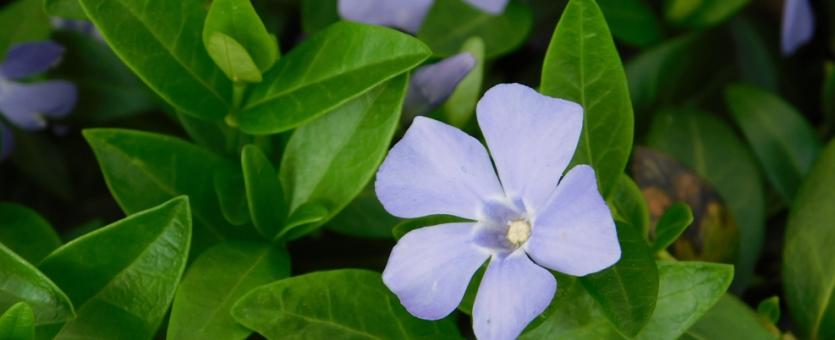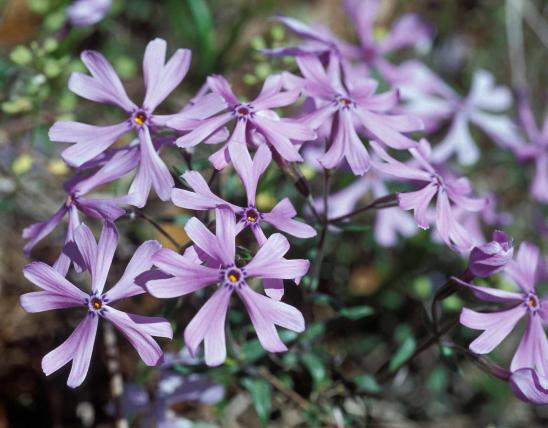
Common periwinkle is a low-growing mat-forming, vine-like perennial nonwoody plant with green, shiny, smooth stems that are woody at the base. It spreads by underground runners or by its vine-like stems that take root at the nodes. It is not native to North America and has proven to be invasive in several states. Planting it is not recommended.
The leaves are opposite, simple, evergreen, ½–1½ inches long, ½–¾ inch wide, egg-shaped to equally rounded toward the ends, the tip blunt to pointed, the base rounded or heart-shaped, the margin lacking teeth; upper surface dark green, shiny, smooth, the central vein light green; the lower surface paler, smooth; leaves at the end of twigs often in clusters of 3 or 4, the leaf stalk ½–1¼ inches long, exuding a milky sap when broken.
The flowers are lilac to blue, 1 inch across, similar to phlox flowers, with the petals fused at the base into a narrow tube and the 5 lobes spreading out in a flattened, circular pattern, the tips ending abruptly as if cut off. Blooms March–May.
The fruits rarely develop fully in North America.
Similar species:
- A close relative, greater periwinkle (Vinca major), is another nonnative plant cultivated as an ornamental groundcover, and it also escapes from cultivation. It has larger flowers (1–1½ inches wide) and a more robust growth habit with more ascending flowering branches. The leaves are wider and have hairy margins, and they are not as leathery; they tend to drop or be damaged by very cold weather. Greater periwinkle is invasive in rich, forested habitats in other parts of the eastern and midwestern United States. Because of its aggressive nature, its cultivation is discouraged.
- Wintercreeper (Euonymus fortunei) is rather similar, but the leaves in that invasive species have blunt teeth along the margins and the flowers are small and yellowish white. Also, wintercreeper frequently climbs up trees, fences, and other structures, using aerial rootlets that cling to surfaces, while common periwinkle rarely climbs.
Height: usually to about 6 inches. Stem length: 4–60 inches or more.
Introduced, scattered, mostly south of the Missouri River. Cultivated statewide and can escape into natural habitats statewide.
Habitat and Conservation
Cultivated statewide as a groundcover, common periwinkle can escape into natural habitats or persist long after it has been introduced. In natural habitats, it can become established in bottomland forests and rich upland forests and woodlands and along banks of streams and rivers. You might also encounter it in abandoned homesites, cemeteries, ditches, roadsides, and shaded, disturbed areas.
Although common periwinkle rarely produces viable seeds in North America, it spreads easily by cuttings. Pieces of plants discarded by gardeners can take root in new areas, creating new colonies.
Status
Nonnative plant used as an ornamental groundcover. Potentially invasive; labeled invasive in several states. Frequently escapes from cultivation. Because of its potential for outcompeting native plants, it is not recommended for planting in Missouri.
Human Connections
Common periwinkle remains available at garden centers. Sometimes it is sold in a variegated form, with leaves streaked or edged with yellow. This species is not recommended for planting in Missouri. Nearby states have declared it invasive. Vigorous growth and lack of pests are traditionally considered good qualities in garden plants, but plants that are difficult to control present problems for gardeners.
Gardeners and landscapers contribute to the invasive spread of common periwinkle, sometimes unknowingly. The plant easily escapes from cultivation by pieces of plants that are discarded by gardeners or that are washed into drainages from nearby plantings. Once it gets established in natural settings, it chokes out native wildflowers such as violets, wake robins, wild ginger, rue anemones, and dogtooth violets.
Common periwinkle and its relatives produce several chemicals that have been extracted (or manufactured synthetically) and used as drugs for a variety of ailments, including cancer.
Periwinkle is the name of a color. This lavender blue, or light shade of purple, was named after the flowers of this species. The first use of “periwinkle” in English as a color name was in 1922. The Crayola company introduced its “periwinkle” crayon in 1949.
The name “periwinkle” is derived from the Classical Latin name for the plant, vincapervinca, which gave rise to the scientific genus name; pervinca and periwinkle are essentially the same word.
In case you're wondering, the name for the small sea snails called periwinkles has a different origin and meaning; that name comes from Latin and Greek roots pina, for a type of mussel, and the Old English -wincle, a Germanic, not Latin, word for a kind of snail shell.
Ecosystem Connections
When common periwinkle becomes established in native habitats, it can form large mats and outcompete a variety of native plants, degrading and reducing natural ecosystems. With fewer native plants available for pollinators and other native insects, it means less food for nesting birds and other animals that hunt insects.
Common periwinkle’s toxic foliage is unpalatable to mammals, and few animals eat it. With few seeds set, seed-eating birds largely ignore the plant. Additionally, few insects seem to visit the flowers, so it offers little to our native pollinators. Plants that are not eaten by native insects are failing to fulfill a role in the ecosystem by not feeding insects that in turn become food for birds.
Common periwinkle has often been used to help bind soils and prevent erosion, but its stubborn persistence and capacity for suppressing native plants (which can hold soils and prevent erosion just as well) diminish its desirability.






























